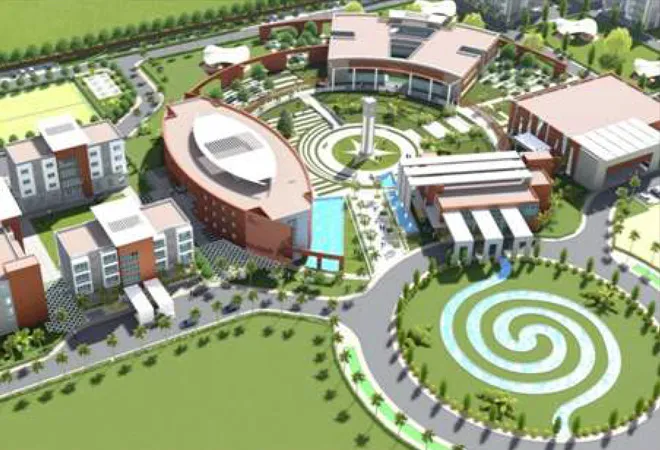
Finance Minister Nirmala Sitharaman in her maiden budget announced several initiatives to diversify India’s stagnating rural economy, such as: setting up of 100 new rural artisanal clusters, 80 livelihood incubators and 20 technology business incubators to train 75,0000 entrepreneurs in agribusiness skills; and formation of 10,000 new farmer producer organisations. Moreover, there is a thrust to improve connectivity by upgrading 1,25,000 km new roads, under the PMGSY (Pradhan Mantri Gram Sadak Yojana) scheme.
Shrinking land-man ratio is a prime factor impacting the ability of the agriculture sector to generate more jobs for the burgeoning rural population of India. According to the Agriculture Census 2010-11, the average land holding size is only 1.15 hectares. Cultivation alone can no longer provide livelihood sustanance for 70 percent of those farm households, who possess less than one-hectare land holding. As per the National Sample Survey (70th Round) estimates, the average monthly consumption expenditure of such marginal farmers is higher than their income through cultivation.
The rising rural population may further fragment agricultural land parcels. According to the United Nations World Urbanisation Prospects (2018), India’s rural population is projected to climb up from 856 million in 2011 to reach the peak of 909 million by 2027, before starting to slowly taper-off. Although, India is projected to become 50 percent urban around 2045, nevertheless, the rural population would continue to be substantial in absolute number terms,especially in states like UP and Bihar.
Thus, generation of non-farm employment opportunities for surplus rural workforce has become an imperative for India’s economic policy. Under these circumstances, the Union Budget’s emphasis towards rural industrialisation is a step in the right direction, but is not yet a roadmap.
Cluster development schemes to boost rural growth launched earlier, such as 300 clusters, under the Shyama Prasad Mukherjee National Rurbun Mission or 42 Mega Food Parks, had been slow to take-off. The cluster and connectivity centric central initiatives have strong spatial connotations. But, their rolling out would largely depend on the planning and governance capacities of the state governments, as land is a state subject under the constitution. The centre needs to play a proactive, catalytic role and nudge the state governments to put in place a robust institutional platform which can integrate land, labour and capital requirements, thereby cutting across rural-urban administrative binaries and sectoral silos.
To fast-track rural industrialisation, generate jobs and growth, the farmer producer organisations, agribusiness entrepreneurs and artisanal clusters need to be strategically located near transportation interchanges in small urban settlements—especially mandi towns, to attain an economy of scale, generate multiplier effects and better supply-chain logistics. Whereas the agglomeration gains could significantly fritter away, if the projects are randomly dispersed to remote areas.
Mandi towns like Ara (Bihar) and Bidar (Karnataka) are linchpins of agrarian economy and are deeply tied with their surrounding rural belt as hubs of agricultural produce marketing, farmer’s cooperative banks, micro-credit institutions and retailing of farm equipment. They play vital intermediary roles in agro-economy value chains linking rural fields to urban markets as nodes of articulation for capital, labour, produce, raw material and information flows.
The spatial targeting of public investments in a strategic manner could kick-off an agriculture-led agglomeration process around the mandi towns and galvanise their rural peripheries in at least three significant ways.
First, the clustering of artisanal crafts and small-scale agro-processing units offer opportunities for: peer-learning and firm to firm knowledge spill-over; facilitating the sharing of orders, contracts, and expensive machineries; reducing transportation costs in sourcing and delivery processes.
Second, co-location of agro-economy activities could trigger multiplier effect and encourage further investments from related trades such as packaging industries, transportation and logistics firms, agro-machinery dealers and maintenance workshops, as well as off-course support infrastructure in the form of education, healthcare, residential and retail functions.
Third, the agro-driven urbanisation process could stimulate the construction activities in these small towns and generate jobs for the surplus farm-labour from neighbouring villages. Casual jobs in the construction industry has low entry barriers and are vital for the livelihood strategies of the rural poor.
Governance systems of India, which had remained stuck in rural-urban dichotomies are unable to leverage the potentials of an agriculture-led, bottom-up urbanisation. Meanwhile, undetected by the policy ladder, rural India is transforming through informal, local processes. The number of Census Towns increased from 1362 in 2011, to 3894 in 2011. These settlements meet census norms to be classified as ‘urban’, due to population, density and occupational characters, but continue to be governed as ‘rural’. A majority of these Census Towns reflect in-situ processes of urbanisation, financed by local agricultural capital and generate non-farm livelihood opportunities for local labour.
To maximise their growth potential and also contain the adverse ecological fallout of uncontrolled conversion of fertile agricultural land into urban real estate, the agricultural towns and their rural peripheries require to be planned through an integrated spatio-economic framework. The PMGSY funds can deliver better value per kilometre, if the rural roads are aligned to strengthen hub-and-spoke connectivity between the agro-processing and artisanal clusters and their supply hinterlands, rather than built in isolation.
When it comes to integrated planning, South Africa’s recent initiatives could possibly provide certain policy inputs. South Africa’s National Development Plan Vision 2030 articulated the vision of boosting small town economies to address rural poverty. Accordingly, one agro-park cluster is being developed in each of the country's 44 districts. The centre piece of the programme is the Spatial Planning and Land Use Management Act (SPLUMA), which has put in place an elaborate institutional architecture for horizontal and vertical coordination between various sectoral departments and line agencies for plan implementation.
The district administrations have been entrusted as nodal agencies, for planning and implementation. They are required to frame comprehensive business plans and marketing strategies, develop landuse master plans, assess infrastructure shortfalls and figure out training and skill gaps for the local population. Thus, the overarching development plan is not only informed by local priorities, it also ensures closer alignment between economic and spatial objectives.
In India, constitutional provisions for such integrated planning exist through the District Planning framework under Article 243ZD of the Constitution since the local government reforms of 1992, but are not fully operationalised. Although 20 out of the 29 states had constituted the District Planning Committees, due to pressure from the erstwhile Planning Commission, but many are yet to empower, fund and staff them adequately. Meanwhile, central and state government missions are being rolled out one after another and are being managed by project management consultants in an isolated manner. The rolling back of the Planning Commission has shifted the onus of integration and convergence to the state level, but a viable institutional mechanism is yet to emerge.
A roadmap for agriculture-led urbanisation pivoting around small towns is essential to industrialise rural India and generate rural jobs. Small mandi town economies need to be galvanised through strategic targeting of clusters and connecting transportation grids to value chains.
However, for this to happen, the central government needs to impress upon the state to institutionalise a platform for integrated planning, maybe by incentivising through funds in its disposal.
The views expressed above belong to the author(s). ORF research and analyses now available on Telegram! Click here to access our curated content — blogs, longforms and interviews.




 PREV
PREV


